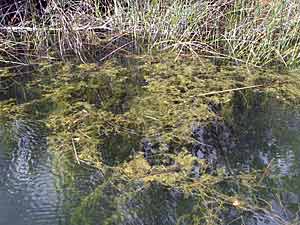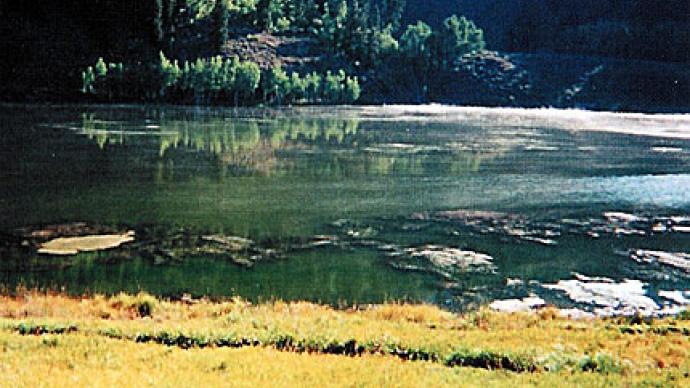
Algae..it's not a four letter word. Algae are simple organisms living wet, oceans, lakes, rivers and ponds. Yes, your ponds. Algae even lives in moist soils. Worldwide, scientists have identified more than 15,000 species. Some species are single cell plants, others consist of more than one cell, or colonies of cells.
Algae are primary producers in the food-chain. They absorb nutrients from soil and water and the atmosphere, feeding primarily on nitrogen. In turn, microscopic single cell algaes feed other organisms. When a pond or lake is fertilized, the initial bloom often consists primarily of algae, which normally feeds other phytoplankton which feeds zooplankton, which feeds other creatures further up the food chain.
Single cell algae tint water, usually different shades of green. Lime green, pea soup green, olive green...all colors commonly attributed to different colonies of species suspended in the water column.
Filamentous algae is that stringy, slimy, bubbly gunky looking stuff that surrounds a pond, sloughs and forms ugly floating mats.
Here's the bottom line. Algae exists. If you don't have it, you probably will. A volatile plant, algae can grow one day, be gone the next. You may go months without any, then can't get rid of it for weeks.
If you have it, and don't want it, what's a pondmeister to do? Several options exist. You can leave it alone. Algae comes, algae goes. Cool weather, lots of algae. Cold weather, filamentous algae disappears, but planktonic or bluegreen algae may exist, especially in northern waters. Hot weather, filamentous is gone. Temperature and food sources are nature's controls.
Want to remove your algae? Two basic options exist. Approved herbicides, mostly copper based, are what most professionals use. Herbicides are quick acting, and algae disappears fast. But, I remember algae comes and goes quickly. Use an algaecide, plants die, but can regrow within a week or two. Algaecides cost from $20-40.00 per acre, plus application fees, if a pro does it.
Organic methods are widely accepted for algae treatment. For years, barley straw has been used to fight runaway algae. But, there's no label telling anyone how to do it, and no approval from any agency. You are on your own. Barley straw works. Some of the organic gardening gurus around the country recommend using industrial corn meal. Seems decomposition of corn meal gives off a toxin which knocks algae straight on its head. Then, there's a myriad of bacterial products. Inoculate with beneficial bacteria, then add maintenance doses every other week, until algae season is over. Recommended initial doses range from 3-7 pounds per surface acre, then maintenance doses at half the rate every other week. Budget $20-30 per pound of bacteria.
As ugly as the stuff is, algae is a sign of the times. It's a sign of nature, using excessive amounts of specific nutrients, in specific windows of temperature opportunity.
Reprinted with permission from Pond Boss Magazine



